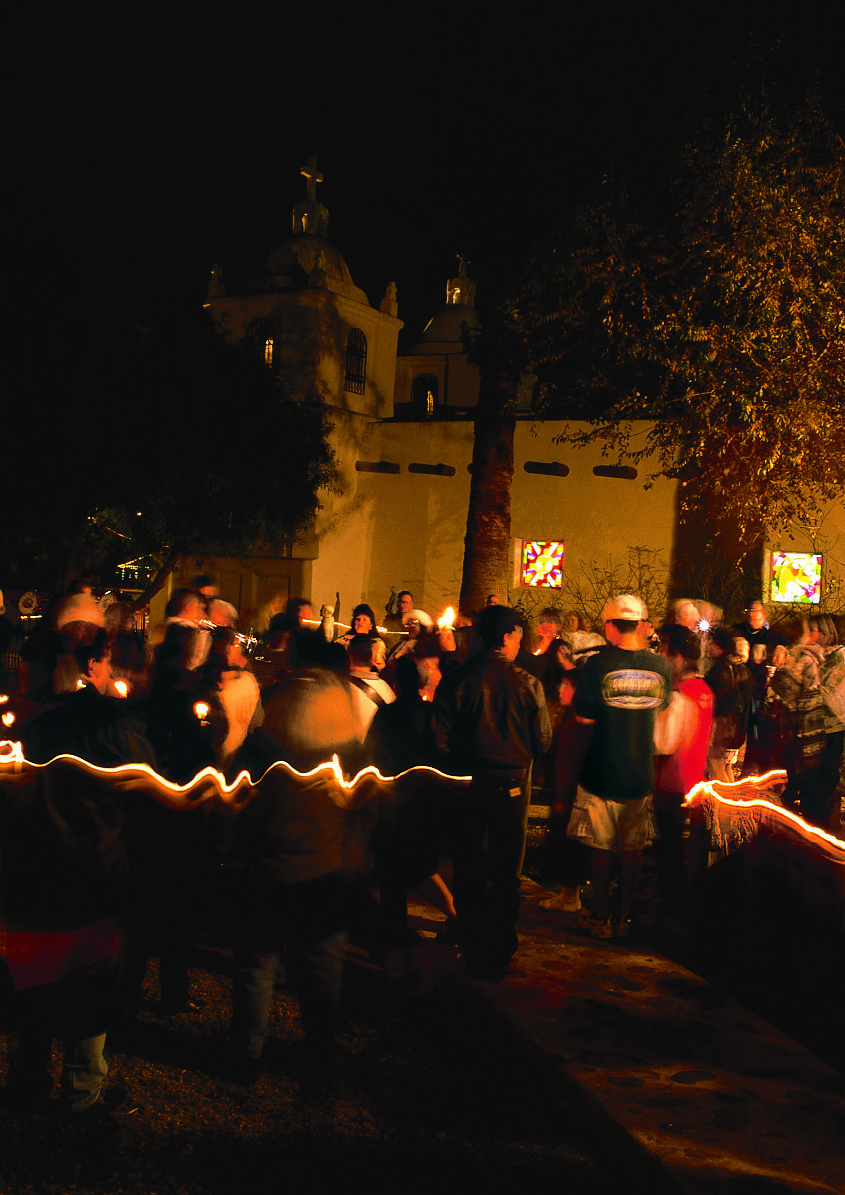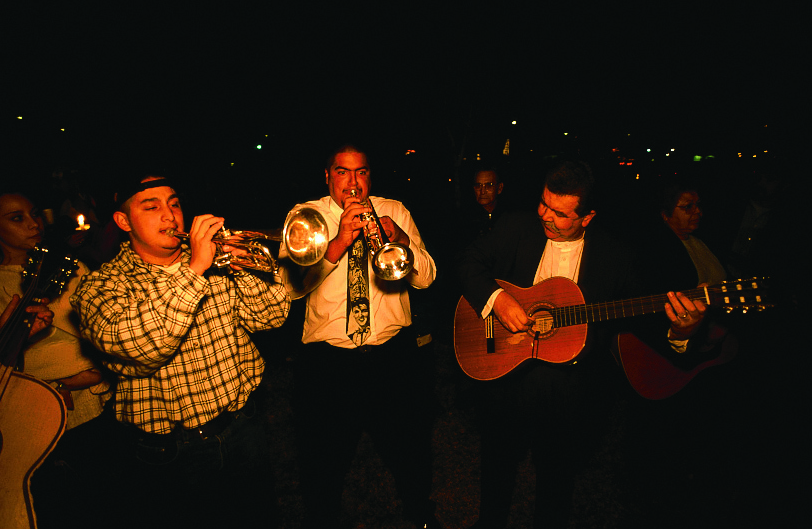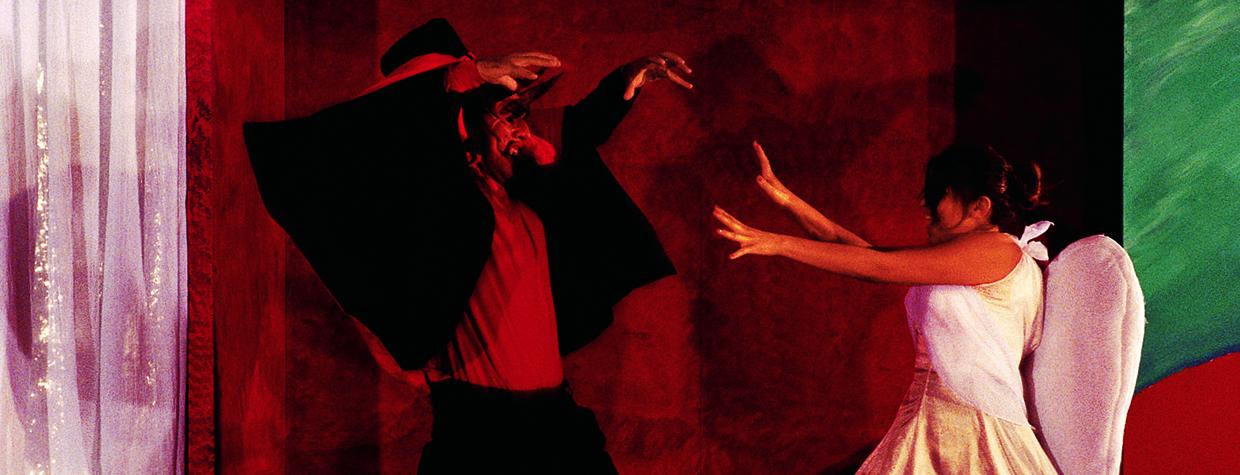The very first Christmas Eve: The "Archangel Michael" struggles to get the attention of a group of preoccupied shepherds. She's having a tough time: The wise old man of the shepherds, Bartolo, doesn't hear so well.
"I bring you news from on high'" she announces, her expression a picture of beatific joy.
"From Ohio?" wonders the incredulous Bartolo, waving his shepherd's crook in the direction of the Midwest.
The Archangel makes an appeal heavenward.
"Look up! Look up'" says director Rodrigo Duarte Clark. When the actress portraying the chief angel tries to pull that off, her nose almost bumps the ceiling of the impromptu rehearsal site, the Instituto Cesar Chavez Center in Guadalupe. "Try to imagine you're in the church," he reminds her, then he continues to the rest of the acting troupe: "Don't forget, the audience is in an L-shape. You have to reach them all." He pushes a boombox button to cue the next scene.

When the show opens a few nights later at Our Lady of Guadalupe Churcn, it all comes together beautifully, with music and lights and a spectacularly masked Satan — and the audience experiences a new take on the Christmas story.
Forget that whole Galilee business. Here's what really happened on that cold, clear December evening 1,999 years ago: The Star of Bethlehem appeared to a group of Yaqui shepherds camped in the remote Yaqui Valley. The Archangel Michael, a bit of an ingenue, ran into a few challenges when she tried to convince these rustics of the facts of the infant Jesus' birth. They were all preoccupied with their private concerns, which involved small failings like gluttony, pride, cowardice, and shrewishness.
Then she had to fight off Satan himself, who, for obvious reasons, took an unholy interest in the arrival of competition for the souls of humankind. Stage that tale in an authentic Southwestern adobe church, and you have a play at once warm, human, and hilarious.
This kind of Christmas performance is known as a pastorela, a Mexican folk tradition dating to the 16th century. The show in Guadalupe, a tiny Indo-Latino community engulfed by East Valley sprawl, blends an old custom with new institutions to "give voice to community concerns through the arts," as Arizona State University Public Events Coordinator Andreya Hernandez puts it. This kickoff to an annual series brought together the national American Festival Project, a California professional theater company called El Teatro de la Esperanza, a Guadalupe service organization called Centro de Amistad, internationally trained artist and maskmaker Zarco Guerrero, and a troupe of gifted local actors. The whole chaotic bunch was organized by ASU Public Events as part of a series called the Untold Stories Festival, which in 1998 and '99 brought five national performing arts groups for residencies in Arizona.
"It's the completion of a dream," says Santos Bernasconi, a deacon at Our Lady of Guadalupe Catholic Church. "I had long thought this was something that could pull the community together, and when Andreya called, I realized this could be my only shot at getting it done."
Before long, Hernandez had introduced Bernasconi to Duarte Clark and a host of local talent - and the dream was on its way to becoming reality Bernasconi envisioned an elaborate production in the classically Southwestern mission-style adobe church, complete with matachines, Mexican religious dancers, and a traditional Christmas posada, or procession.

The casts main attraction, no question of it, was the Devil himself, played by Guerrero. He was terrifying; he was engaging; he was evil incarnate and deception made tangible. And he was very, very funny.
El Zarco, as he likes to be known, is a performer as well as an artist. He has worked with the Desert Dance Theater and Childsplay For the past 20 years, he has studied and practiced the art of mask-making; in Japan he studied the Noh Mask tradition, and in Bali, Mexico, China, and Alaska, he learned elements of indigenous mask-making traditions. The result is a brilliant figuration of outrageous faces that, even hanging on a wall, seem to jump to life. When such a depiction appears on the human face, the effect is eerie.
For La Pastorela, Zarco created a rascally horned devil, carving two masks, to accommodate the disguises the Devil uses to hoodwink the shepherds. As an extra flourish, he made special child-size masks for his children and had them prance into the church as diabolitos.
"The original inspiration came from Mexican masks - Yaqui, specifically," he says. His own Yaqui heritage, he reflects, ultimately brought him from portraiture to mask-making. Although he did not grow up in Guadalupe, his father (also an artist) would take him to the towns Yaqui Easter ceremonies, where the colorful masks and dances fired his imagination. In the 1970s, when the Chicano political and artistic movements began to flourish in California, he realized that the Chicano community, with such traditions as Dia de las Muertos (a day to celebrate the dead), was "a perfect venue for the mask."
Rodrigo Duarte Clark's Teatro de la Esperanza is one product of the early Chicano movement. Based in San Francisco, the company became active during the administration of Governor Jerry Brown, bringing education and political messages to farm workers through drama.

Duarte Clark, who seems unfazed by the difficulty of choreographing each position, step, phrase, and tone in a setting alto gether unlike the plays real "stage," reflects on the origins of the traditional pastorela, which was introduced by Spanish colonial missionaries as a way to bring scripture to the local people. "In Mexico," he says, "a secularization took place. Some [pastorelas] are very earthy, even vulgar."
Duarte Clark wrote the script for Guadalupe's pastorela, blending earthy and spiritual, new and old. Comically conscious of the ambiguity of their time and place, the shepherds tell book-happy Felino that he couldn't have studied at the Sorbonne, because its the first century A. D. , and Paris has yet to be built. "It's outside of time," Santos Bernasconi remarks, smiling at the oddly pleasing effect.
A blend of old and new exactly fits the people of the tiny town of Guadalupe, who have managed to cling to many of their Yaqui and Chicano traditions despite finding themselves just down the road from an enormous factory outlet mall and surrounded by new housing. Zarco sees the chance to perform in the church at Guadalupe as a turning point. "Now that Rodrigo has planted the seed, it will grow artistically," he says. "We want to entice everybody to come into the church. Art is a way of sharing our humanity."

